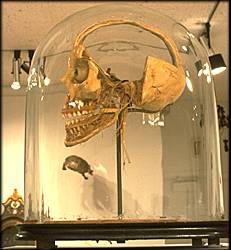 [for larger image] |
Human skull,
with eye and optic nerves
reproduced in wax.
Made in France in the late nineteenth-century
Anthropology
This human skull with its exposed optical organs sits at the apex of the grouping of animal, vegetable, mineral. It represents the viewer's curious eye as the activating agent of the myriad possible relationships among objects in the curiosity cabinet. The curiosity cabinet was anthropocentric both conceptually and practically: the true center of the collection was its viewer who could survey and comprehend the entire assemblage and, by extension the world itself. As the viewer stands in relation to our curiosity cabinet, so stands the cabinet to the university, and the university in relation to the universe itself.

